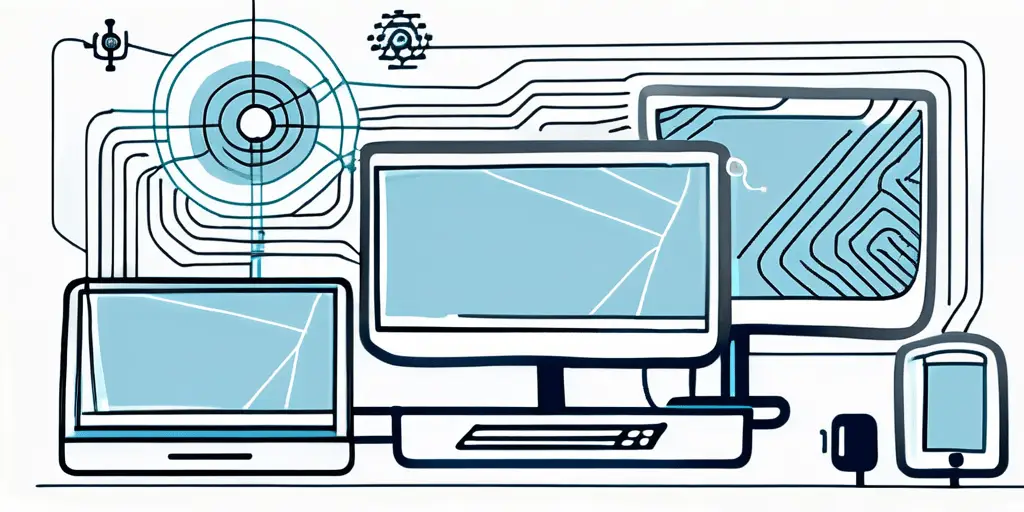In today’s digital age, where online communication and transactions have become the norm, it is crucial to understand the various threats that can compromise the security of these interactions. One such threat is the Man-in-the-Middle (MitM) attack, which involves intercepting and altering the communication between two parties without their knowledge or consent. By exploiting vulnerabilities in the communication channel, attackers can gain unauthorized access to sensitive information and even manipulate the contents of the communication. Understanding how these attacks work is essential to protect ourselves and our businesses from potential harm.
Understanding the Concept of Man-in-the-Middle Attacks
Before delving into the technicalities of MitM attacks, let’s start with a basic explanation of the concept. In a Man-in-the-Middle attack, an attacker positions themselves between the sender and the recipient of a communication. The attacker intercepts the communication, making it appear as though they are the intended recipient to the sender, and vice versa. This position allows the attacker to eavesdrop on the conversation, alter the contents, or even inject malicious data into the communication without the knowledge of the communicating parties.

Definition and Basic Explanation
A Man-in-the-Middle attack, also known as an eavesdropping attack or bucket brigade attack, is a cybersecurity threat where an attacker secretly intercepts and relays communication between two parties without their knowledge or consent. By exploiting vulnerabilities in the communication channel, the attacker can gain access to sensitive information or manipulate the contents of the communication.
The Role of Encryption in MitM Attacks
Encryption plays a vital role in securing digital communication and protecting against MitM attacks. It involves encoding the information in a way that only authorized parties can decipher it. However, if an attacker successfully positions themselves in the middle of the communication, they can intercept the encrypted data and try to break the encryption to gain access to the plaintext information. Weak encryption algorithms or misconfigured encryption settings can leave the communication vulnerable to MitM attacks.
Let’s take a closer look at how encryption works in the context of MitM attacks. When two parties engage in secure communication, they use encryption algorithms to encode their messages. These algorithms rely on complex mathematical calculations and cryptographic keys to transform the plaintext into ciphertext. The ciphertext is then transmitted over the communication channel, making it difficult for an attacker to understand the content without the corresponding decryption key.
However, in a Man-in-the-Middle attack, the attacker can exploit vulnerabilities in the encryption process. For example, they may trick one party into using a weaker encryption algorithm or manipulate the encryption settings to make it easier for them to break the encryption. Once they successfully intercept the encrypted data, they can launch various attacks, such as decrypting the data themselves or performing a replay attack by resending the intercepted ciphertext to the intended recipient.
To mitigate the risk of MitM attacks, it is crucial to implement strong encryption protocols and regularly update them to address any known vulnerabilities. Additionally, using secure communication channels, such as Virtual Private Networks (VPNs) or Secure Sockets Layer (SSL) certificates, can add an extra layer of protection against potential attackers. By staying vigilant and adopting best practices in encryption, individuals and organizations can minimize the risk of falling victim to Man-in-the-Middle attacks.
The Technical Mechanism Behind Man-in-the-Middle Attacks
Now that we understand the concept of MitM attacks, let’s explore the technical mechanisms that facilitate their execution.
Man-in-the-Middle (MitM) attacks are a type of cyber threat where an unauthorized third party intercepts and potentially alters the communication between two parties without their knowledge. This nefarious activity can compromise sensitive information, breach privacy, and lead to various forms of cybercrime.
Packet Interception and Decryption
In a MitM attack, the attacker intercepts the communication packets flowing between the sender and the recipient. These packets contain the information being exchanged. By intercepting and decrypting the packets, the attacker can access the contents of the communication. This interception can occur at various points, such as a compromised router, a vulnerable network, or even malware-infected devices.
One common method used in packet interception is ARP spoofing, where the attacker sends falsified Address Resolution Protocol (ARP) messages over a local area network. This results in linking the attacker’s MAC address with the IP address of a legitimate network node, allowing the attacker to intercept data intended for that node.
Alteration and Injection of Communication
Once the attacker has successfully intercepted the communication, they have the ability to alter the contents of the communication or inject malicious data. For example, they can modify the content of an email before it reaches the recipient or inject malicious code into a website the victim is visiting. These alterations and injections can have significant consequences, ranging from phishing attacks to financial fraud or data theft.
Furthermore, in some advanced MitM attacks, the attacker may not only intercept and alter data but also perform a technique known as “session hijacking.” This involves taking over an ongoing communication session between two parties, allowing the attacker to impersonate each party and manipulate the conversation to their advantage.
Different Types of Man-in-the-Middle Attacks
Man-in-the-Middle attacks can take various forms, each exploiting different vulnerabilities or weaknesses in the communication channel. Let’s examine some of the most common types:

IP Spoofing
IP Spoofing involves impersonating another device’s IP address to gain unauthorized access or manipulate communication. By forging the IP address, the attacker can deceive the recipient into thinking that the communication is originating from a trusted source. This type of attack can be detrimental, as it enables the attacker to trick the recipient into revealing sensitive information or performing actions they wouldn’t normally do.
Imagine a scenario where an unsuspecting user receives an email from what appears to be their bank, asking them to update their account information. The email looks legitimate, complete with the bank’s logo and branding. However, unbeknownst to the user, the email has been sent by an attacker who has spoofed the bank’s IP address. When the user clicks on the link provided in the email and enters their account details, the attacker captures this information and gains unauthorized access to the user’s account.
DNS Spoofing
DNS Spoofing, also known as DNS cache poisoning, exploits weaknesses in the domain name system (DNS). By redirecting the victim’s DNS requests to a malicious DNS server, the attacker can manipulate the translation of domain names into IP addresses. This manipulation can lead the victim to interact with malicious websites or unknowingly disclose sensitive information to the attacker.
Consider a situation where a user attempts to access their favorite social media platform by typing the website’s address into their browser. However, due to a DNS spoofing attack, the user’s request is redirected to a malicious website that looks identical to the social media platform. The user, unaware of the manipulation, enters their login credentials, which are then captured by the attacker. This type of attack highlights the importance of verifying the legitimacy of websites and being cautious when entering sensitive information online.
SSL Hijacking
Secure Socket Layer (SSL) and its successor, Transport Layer Security (TLS), are encryption protocols that ensure secure communication over the internet. In SSL hijacking attacks, the attacker intercepts the SSL handshake process between the sender and the recipient. By presenting their own SSL certificate, the attacker can trick both parties into believing they are communicating securely. This allows the attacker to decrypt, alter, or inject data into the communication unnoticed.
Imagine a scenario where a user is making an online purchase and enters their credit card information on a secure website. However, an attacker conducting an SSL hijacking attack intercepts the communication and presents their own SSL certificate. The user, seeing the padlock symbol indicating a secure connection, proceeds with the transaction, unaware that their credit card details are being captured by the attacker. This highlights the importance of verifying the authenticity of SSL certificates and being cautious when entering sensitive information online.
The Impact of Man-in-the-Middle Attacks
The consequences of a successful MitM attack can be severe, affecting both individual privacy and business operations.
Man-in-the-Middle (MitM) attacks are a type of cyber threat where an attacker secretly intercepts and possibly alters the communication between two parties without their knowledge. This form of attack can occur in various scenarios, such as when a user connects to a public Wi-Fi network or when an attacker has compromised a network device.
Threat to Personal Privacy
As individuals, our privacy is fundamental. A MitM attack can compromise our privacy by exposing sensitive information such as login credentials, financial details, or personal conversations. This can lead to identity theft, financial loss, or reputational damage.
Furthermore, in the case of personal devices being targeted, attackers can install malware or spyware, allowing them to monitor all user activities, including keystrokes, browsing history, and even camera and microphone usage. This invasion of privacy can have long-lasting consequences and cause emotional distress to the victim.
Potential Business Risks
Businesses are also at risk from MitM attacks. Attackers can intercept sensitive corporate communications, gain unauthorized access to proprietary information, or manipulate financial transactions. Such attacks can result in financial losses, a loss of customer trust, or damage to the company’s reputation.
Moreover, MitM attacks on businesses can lead to regulatory non-compliance, especially in industries where data protection regulations are stringent. This can result in hefty fines, legal actions, and a tarnished corporate image in the eyes of stakeholders and the public.
Preventing Man-in-the-Middle Attacks
While the threat of MitM attacks may seem daunting, there are measures we can take to mitigate the risk and enhance our security.

Man-in-the-Middle (MitM) attacks occur when a malicious actor intercepts communication between two parties, potentially gaining access to sensitive information such as login credentials, financial details, or personal data. These attacks can occur in various scenarios, including public Wi-Fi networks, insecure websites, or compromised systems. It is crucial for individuals and organizations to be vigilant and proactive in preventing MitM attacks to safeguard their digital assets and privacy.
Importance of Secure Connections
Ensuring secure connections is crucial to protect against MitM attacks. Always verify that the websites you visit have a valid SSL certificate and use encrypted communication protocols like HTTPS. Avoid connecting to public Wi-Fi networks that may be insecure and consider using a virtual private network (VPN) to encrypt your internet traffic.
SSL certificates play a vital role in establishing a secure connection between your browser and the website server. They help authenticate the website’s identity and encrypt data transmitted between the two parties, making it harder for attackers to eavesdrop or tamper with the communication. Additionally, HTTPS encrypts the data exchanged between your browser and the website, adding an extra layer of security to prevent unauthorized access or manipulation.
Utilizing VPNs for Enhanced Security
A VPN creates a secure, encrypted tunnel between your device and the internet, making it difficult for attackers to intercept and manipulate your communication. By routing your traffic through a VPN server, you can protect your data and maintain privacy, even when connecting to untrusted networks.
VPNs are valuable tools for enhancing security and privacy, especially when accessing the internet from public Wi-Fi hotspots or other potentially risky environments. By encrypting your internet traffic and masking your IP address, VPNs help prevent unauthorized surveillance or data interception. It is essential to choose a reputable VPN service provider that prioritizes user privacy and does not log your online activities.
Regular System Updates and Patches
Maintaining up-to-date software is essential to protect against MitM attacks. Software updates often include security patches that address vulnerabilities that could be exploited by attackers. By regularly updating your operating system, applications, and security software, you can ensure that you are protected against known vulnerabilities.
Software vendors frequently release updates to address security flaws and improve the overall stability of their products. Ignoring these updates can leave your devices vulnerable to MitM attacks and other cyber threats. It is recommended to enable automatic updates whenever possible and regularly check for new patches to stay ahead of potential security risks. Additionally, implementing multi-factor authentication and strong, unique passwords for your accounts can further enhance your defense against MitM attacks and unauthorized access.
Future of Man-in-the-Middle Attacks
The threat landscape is constantly evolving, and so are the techniques used in MitM attacks.
Evolving Threat Landscape
As technology advances, so does the sophistication of attackers. New attack vectors and techniques constantly emerge, requiring us to stay vigilant and adapt our security measures accordingly. Organizations must invest in robust cybersecurity strategies that encompass continuous monitoring, employee awareness training, and the adoption of advanced security solutions.
One of the key factors contributing to the evolving threat landscape is the rapid expansion of Internet of Things (IoT) devices. These interconnected devices, ranging from smart home appliances to industrial sensors, create new entry points for cyber attackers to exploit. As the number of IoT devices continues to grow, the attack surface for potential MitM attacks also expands, emphasizing the critical need for proactive security measures.
Advances in MitM Attack Detection and Prevention
On the positive side, cybersecurity professionals and researchers are continually striving to develop better detection and prevention mechanisms to counter MitM attacks. Advanced network monitoring tools, anomaly detection algorithms, and behavior-based analysis techniques are being deployed to detect and mitigate these attacks more effectively.
Furthermore, the rise of artificial intelligence and machine learning technologies is revolutionizing the field of cybersecurity. These technologies enable security systems to adapt and learn from new threats in real-time, enhancing their ability to detect and prevent sophisticated MitM attacks. By harnessing the power of AI-driven security solutions, organizations can proactively defend against evolving cyber threats and stay one step ahead of malicious actors.
By staying informed about the evolving threat landscape and implementing robust security measures, we can strengthen our defenses and reduce the risk of falling victim to Man-in-the-Middle attacks. Remember, vigilance and proactive measures are the key to safeguarding our digital lives.
As the digital threat landscape continues to evolve, so should your cybersecurity defenses. Blue Goat Cyber, a Veteran-Owned business, is at the forefront of providing comprehensive B2B cybersecurity services. Our expertise in medical device cybersecurity, penetration testing, and compliance with HIPAA, FDA, SOC 2, and PCI standards ensures your business is fortified against sophisticated Man-in-the-Middle attacks and other cyber threats. Contact us today for cybersecurity help and partner with a team that’s passionate about securing your business and products.
